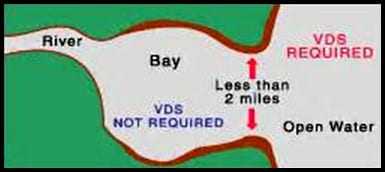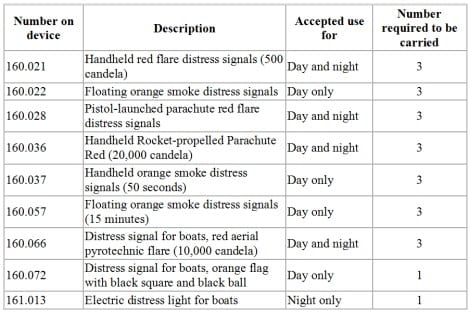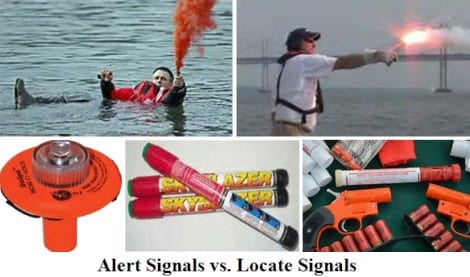 By Bob Currie, Recreational Boating Safety Specialist
By Bob Currie, Recreational Boating Safety Specialist
U. S. Coast Guard Auxiliary Base Galveston Flotilla
I often receive questions from boaters about visual distress signals. Commonly they will say that they never boat at night so why do they have to have visual distress signals on board. The short answer is that the regulations require them, so let’s look at the regs.
Coast Guard Regulations
U.S. Coast Guard regulations require that vessels operating on coastal waters of the United States, the Great Lakes, and territorial seas, as well as those inland waters connected directly to coastal waters, the Great Lakes, and territorial seas from the point of connection to the point at which the waterway narrows to less than two nautical miles wide, must be equipped with U.S. Coast Guard approved visual distress signals.
The Base Galveston Flotilla of the US Coast Guard Auxiliary operates out of the US Coast Guard base on Galveston Island. They aid the Coast Guard by providing maritime observation patrols in Galveston Bay; by providing recreational boating vessel safety checks; and by working alongside Coast Guard members in maritime accident investigation, small boat training, providing a safety zone, Aids to Navigation verification, cooking in base and station galleys and aboard cutters; and on the Coast Guard Drone Team.
Almost all of Galveston East Bay and Galveston West Bay fall under the requirement for visual distress signals (VDS). Recreational boats 16 feet and over are required to carry the following working and unexpired (if expiration is shown) visual distress signals:
- three day and three night pyrotechnic devices,
- one day non-pyrotechnic device (flag) and one night non-pyrotechnic device (auto SOS light), or
- a combination of 1) and 2); Example: One flag and three night pyrotechnic devices

Recreational boats less than 16 feet on coastal waters or the Great Lakes need only carry night visual distress signals when operating from sunset to sunrise. Texas has no further requirements than those required by the Coast Guard. When purchasing pyrotechnic devices, note that some such devices, such as orange smoke devices, are for daytime use only, and thus only meet the daytime requirement of the regulation.
It is recommended, but not required, that boats operating on inland waters should have some means of making a suitable day and night visual distress signal. The number and type of signals is best judged by considering conditions under which the boat will be operating.
The following vessels are not required to carry day signals, but must carry night signals when operating from sunset to sunrise:
- Recreational boats less than 16 feet in length.
- A vessel participating in any organized marine parade, regatta, race, or similar event.
- A manually propelled boat.
- Sailboats less than 26 feet of completely open construction and not equipped with propulsion machinery.
Coast Guard approved devices include:


Pyrotechnic Devices
Must be Coast Guard Approved, in serviceable condition and readily accessible. If they meet the day/night requirement, you need three flares, minimum. They are stamped with an expiration date of 42 months (3 1/2 years from the date they were manufactured). You can keep them after they are expired as extra equipment because they usually will still work, but you can’t count them as part of the Coast Guard’s requirements in a Vessel Safety Check inspection.
“Alert” Signals Draw Attention to Your Emergency
Meteor flares are propelled by black powder and launched from a pistol-shaped handheld holder. They reach an altitude of 375′ to 500′ and burn for 7-8 seconds. Rocket-propelled SOLAS parachute flares rise to 1,000′ and burn for 40 seconds. Fire aerial flares after you have sighted or heard a potential rescue vessel. To attract their attention to your distress situation, the U.S. Coast Guard recommends that you fire two aerial flares – one immediately after the other – so rescuers can confirm the sighting and the direction of the signal.
“Locate” Handheld Flares Show Rescuers Where You Are
Handheld flares burn for one to two minutes. Orange SOLAS smoke flares are for daytime use only and are a good way for offshore boaters to show their location to rescuers searching in a Coast Guard helicopter. They float on the water’s surface and emit a dense orange cloud for three to four minutes. Handheld signal flares are intended as homing signals to pinpoint your position. The surface-to-surface sighting range on water is approximately three to five miles, depending on boat elevation. If a rescuer is five miles away and running at 20 miles per hour, it will take 15 minutes to reach you. Therefore, you should have at least 12 minutes (total burn time) of signals onboard to maintain a strong homing signal until help arrives.
Non-Pyrotechnic Devices
An orange distress flag is 3′ x 3′ square with a black square and ball on an orange background. It’s for daytime use only and is less effective at catching attention than a flare, except that it is not limited by a short burning time. An electric distress signal is approved for night only.
Summary
In our area, if you have a boat that is 16 feet or longer you must have visual distress signals. The “I only operate during the day” argument does not work, as visual distress signals are not just for nighttime operation. Fog conditions also bring out the necessity for using visual distress signals, and visual distress signals have resulted in more people being rescued during the day than at night simply because more boats operate during the day than at night. One of the best ways to ensure that your visual distress signals are current is to undergo a free Vessel Safety Check. We will let you know when your equipment is expired or about to expire.
For more information on boating safety, please visit the Official Website of the U.S. Coast Guard’s Boating Safety Division at www.uscgboating.org. Questions about the US Coast Guard Auxiliary or our free Vessel Safety Check program may be directed to me at [email protected]. I am available to perform free Vessel Safety Checks, and I will come to your location to perform them. SAFE BOATING!
[March-15-2021]

 Posted in
Posted in 
























